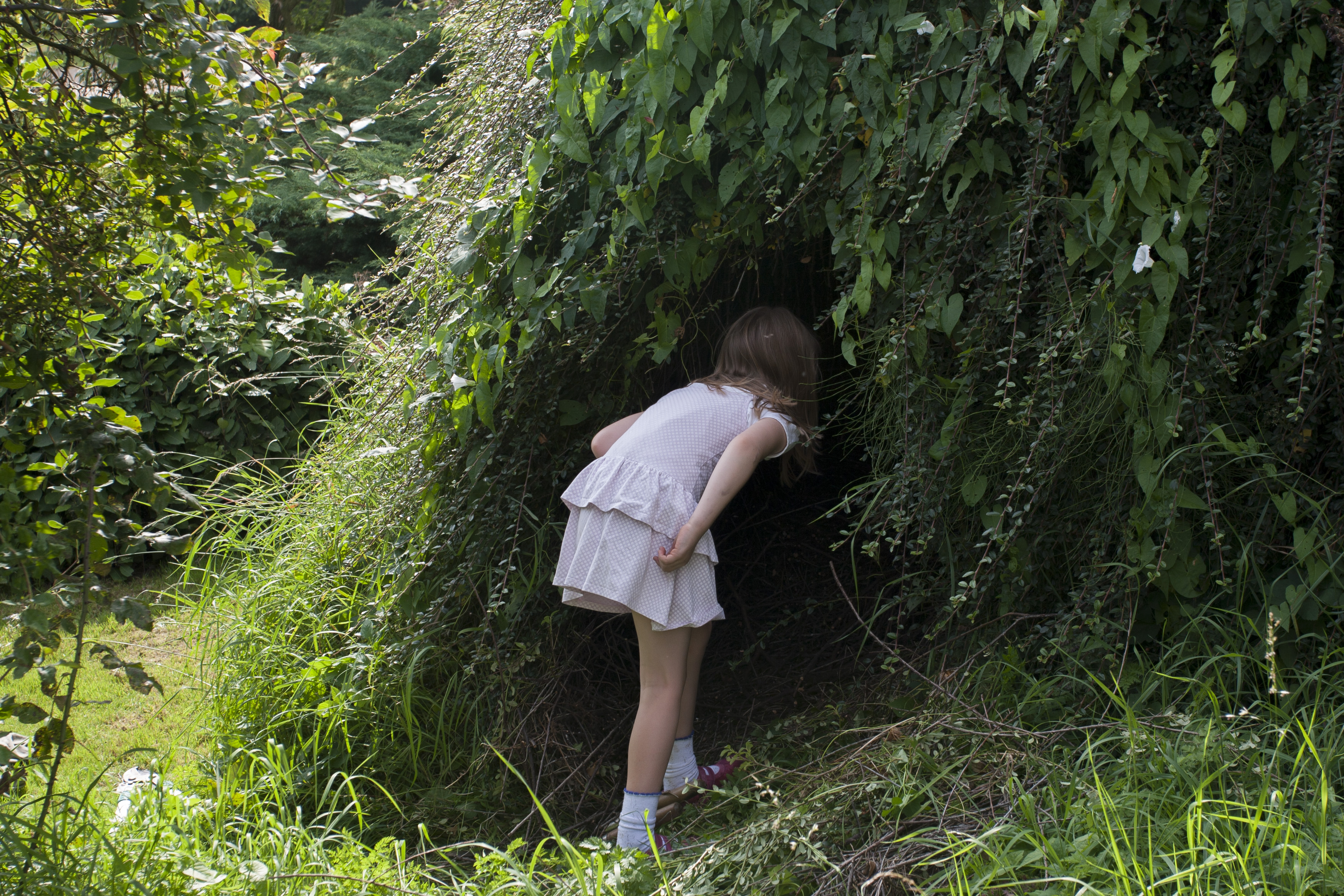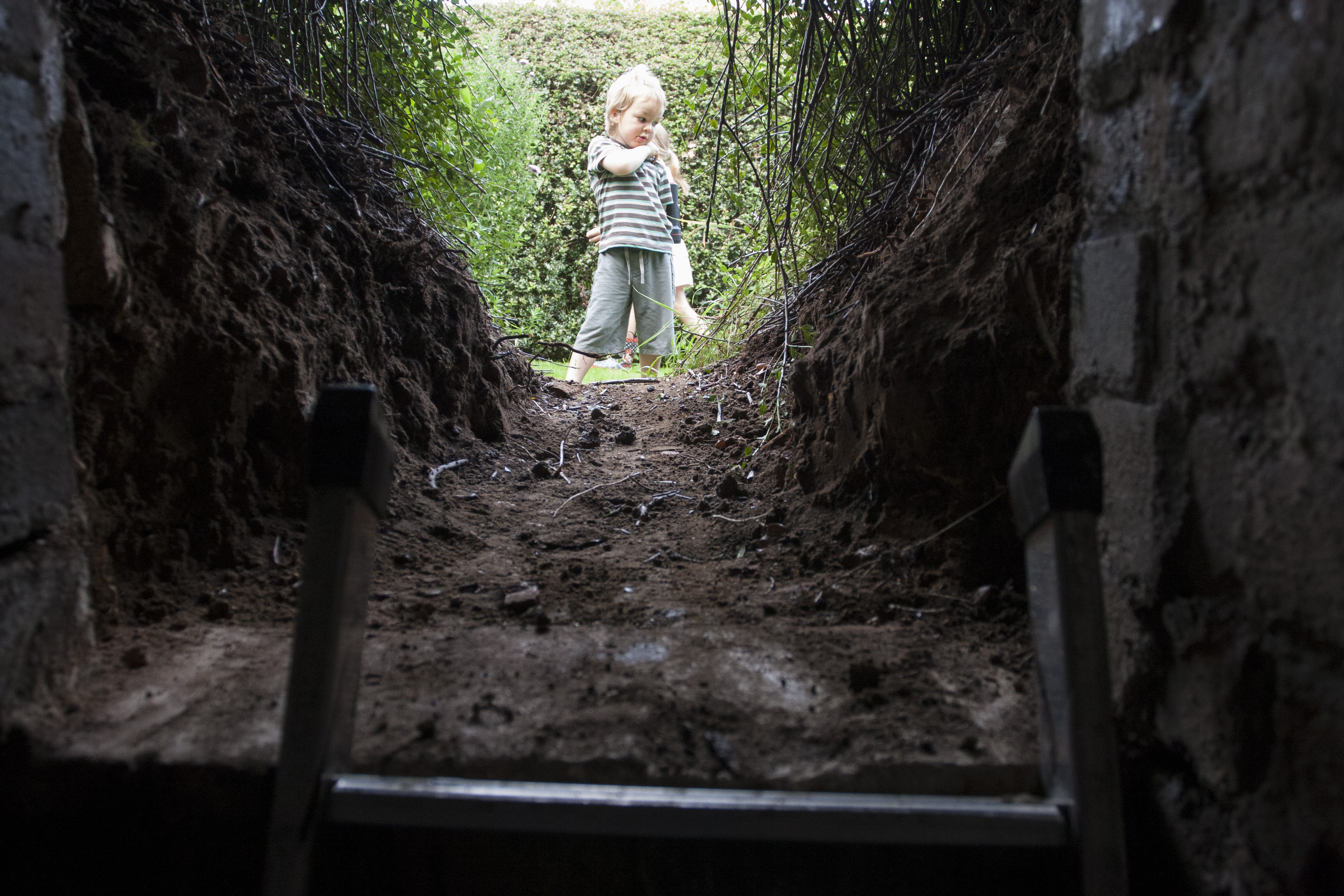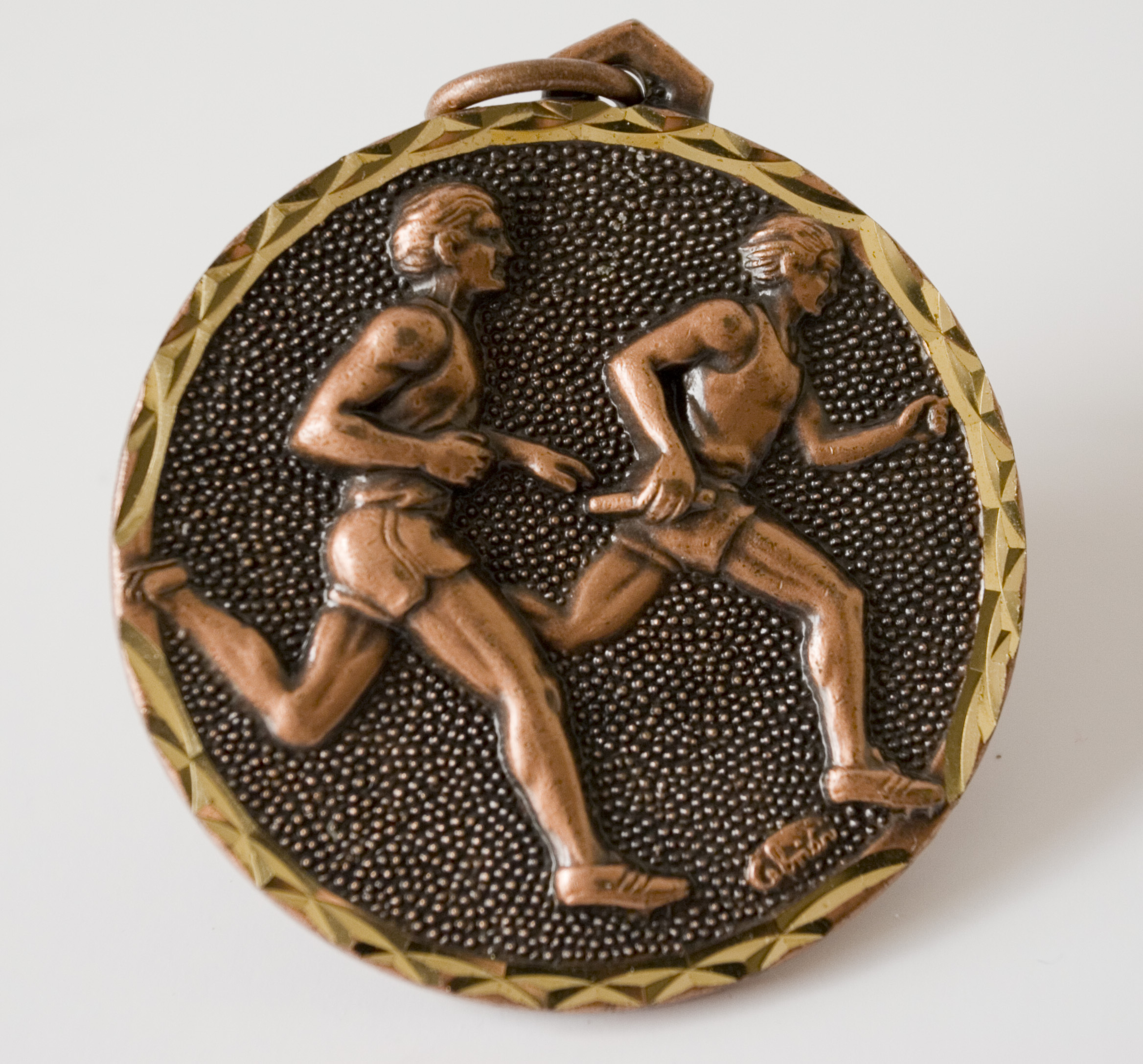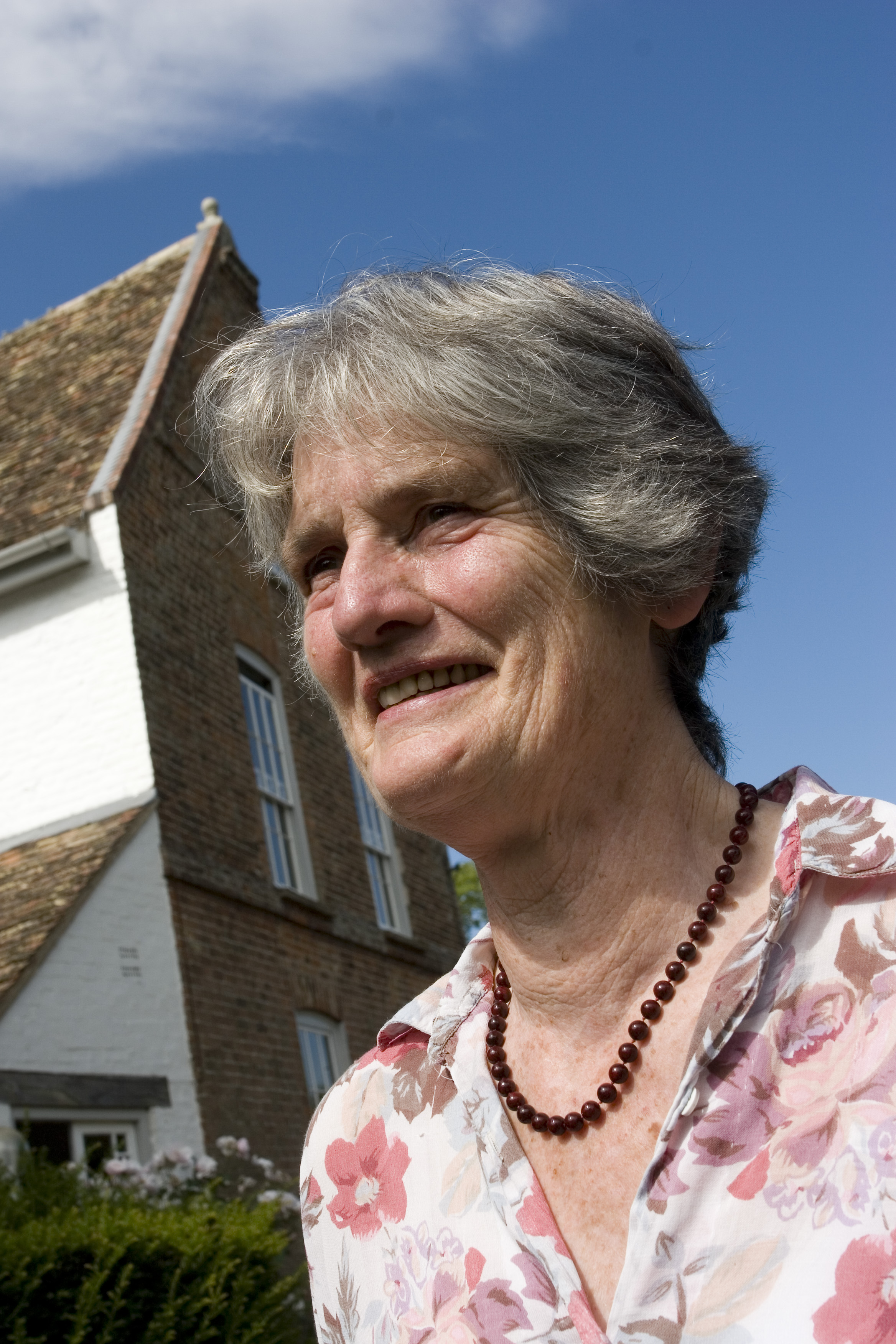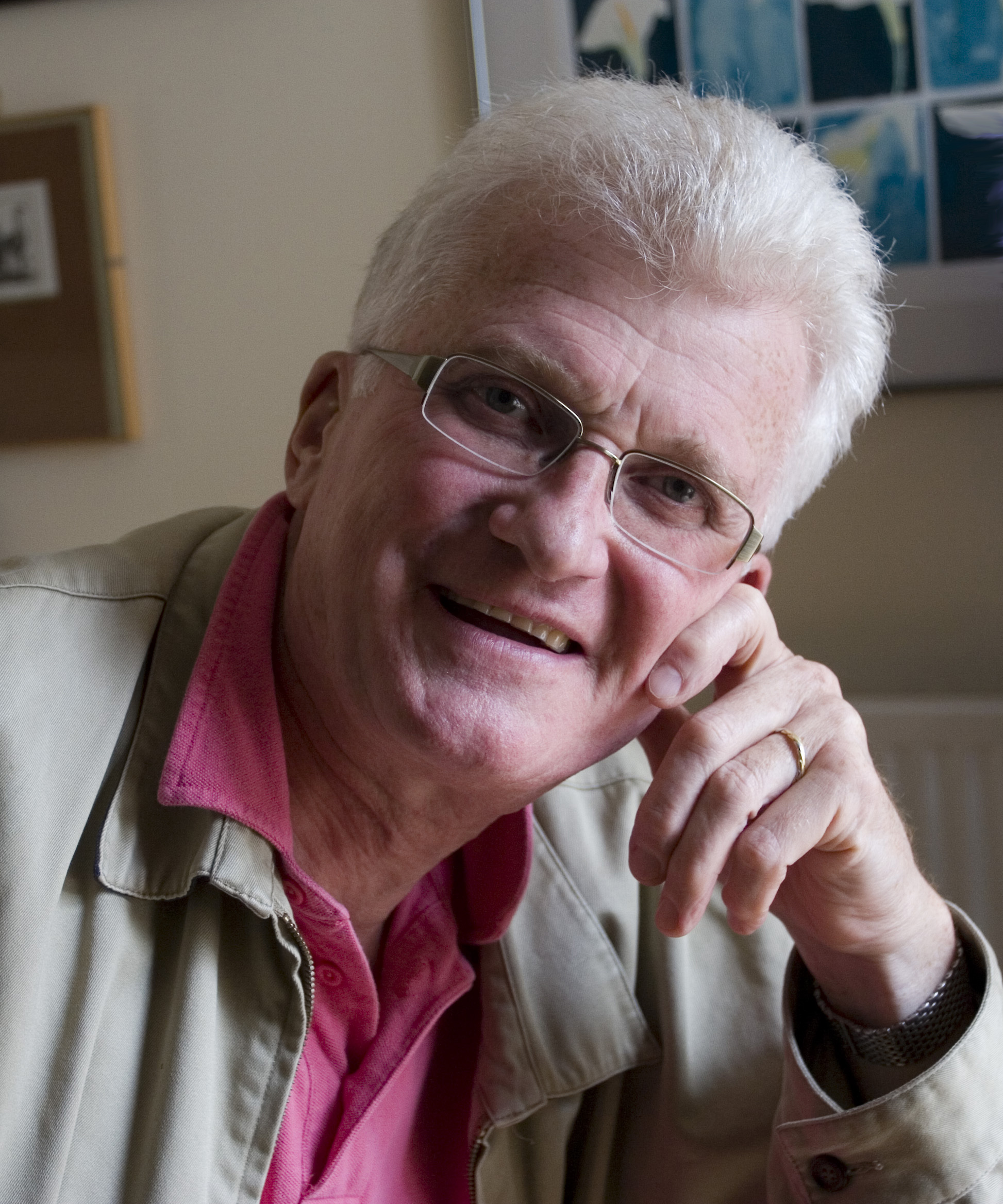In part 1, Diana Boston told the remarkable story of how she came to live and work in the ancient Manor in Hemingford Grey, once home to the famous and much loved children’s author, Lucy Boston. In this second part of our interview, Diana explains what it’s like managing a Grade I listed building which is open to the public, and how the Lucy Boston legacy lives on in film, television and the minds of the visitors to the house.
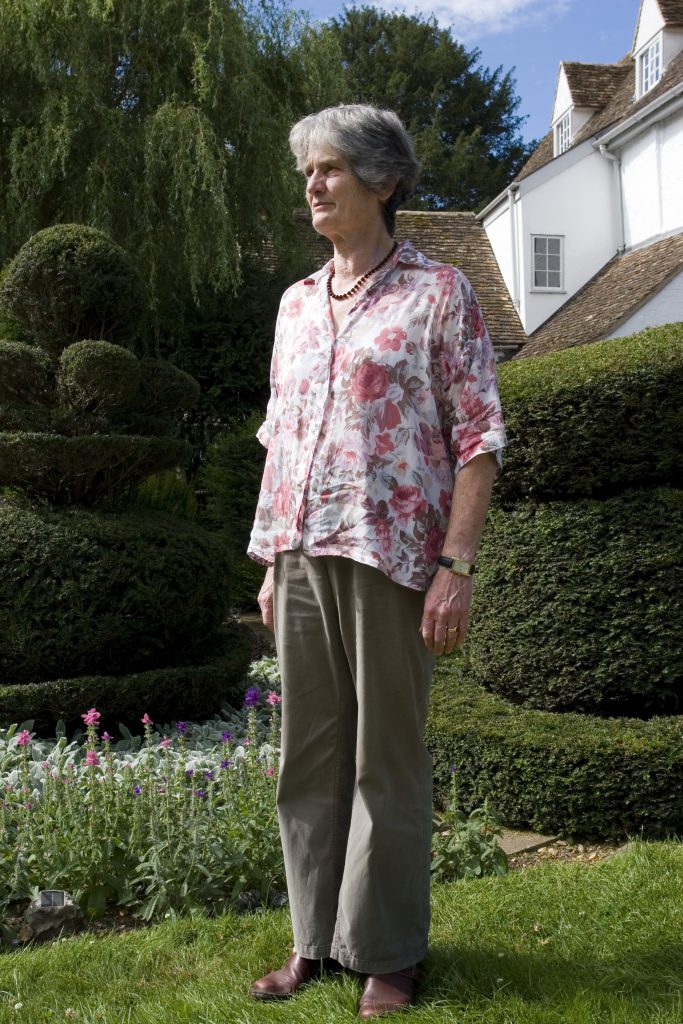
Diana looking out over the garden, towards the river
A Museum for a Home
Diana’s situation is a peculiar one to say the least. Although she has lived at the manor for over 20 years, the house and garden are still very much as they were when Lucy died in 1990. Visitors come to see Lucy’s house rather than Diana’s, and expect it to match the illustrations Peter made for the books many decades ago. Diana explains how she feels about the situation. “I like the Lucy story so I am comfortable living in her museum, which I think Peter wouldn’t have been. I think it was different for him. It could have been very different between mother-in-law and daughter-in-law, but it is fine for me. The Lucy story is what brings the people, although didn’t consciously think about that at the start.
“Certainly when people ring up and say ‘We’d love to make an appointment to come round Lucy Boston’s house,’ I find it quite startling. She died in 1990, so we are now 21 years on. It is my project and it has been my project since the day she died.”
In the media, Diana is often named, but hardly anything gets written about her, such is the public’s focus on Lucy and the Green Knowe of the books. When the matter of her anonymity is put to Diana she laughs, “That’s right, I don’t exist! But I don’t mind that really. I spend my day talking about Lucy. It’s a bit of an exaggeration to say I travel the world, but I certainly go to Japan and spend my time there talking about my mother in law!”
Even having sold the mill in Ashwell, Diana is not in a position where she can do what she likes with the Manor. For a start, the building, parts of which are 900 years old, has a Grade I listing, meaning that it is classified as a building of ‘exceptional interest’ and can only be altered in certain ways and with governmental permission. Then there are the restrictions imposed by conditional capital tax exemption, as Diana explains.
“When Lucy died we had the bank debt and on top of that we had to pay capital tax and death duty, and we couldn’t, or didn’t want to, afford it. So our accountant suggested we went down the route of conditional capital tax exemption. What that means is that if you own a national treasure, which this house is considered to be, as long as you open it to the public you can avoid paying the capital tax. It is conditional – so one day somebody is going to have to pay it, but that’s another issue. If I’d known what I know now there is no way I would have gone down that route.
“That’s in addition to the Grade I listing, so I have to open the house to the public for 28 days a year, but I actually open for many more because the house and the garden are hugely expensive to keep, so 28 days of opening would never generate enough income!
“They also did a survey of the garden so I have to keep that the same too. Obviously you can’t keep a garden set in stone, but I have to send a report every year to say what I have done; if I have planted new trees, changed anything. They come here every five years to do an inspection and just make sure I am doing what I am supposed to be doing.
“Most of what they want to see is in the house but I wouldn’t get rid of those things anyway. Some of things in the books she made up, of course. The one topiary in the garden that they really want to see is the green deer.”
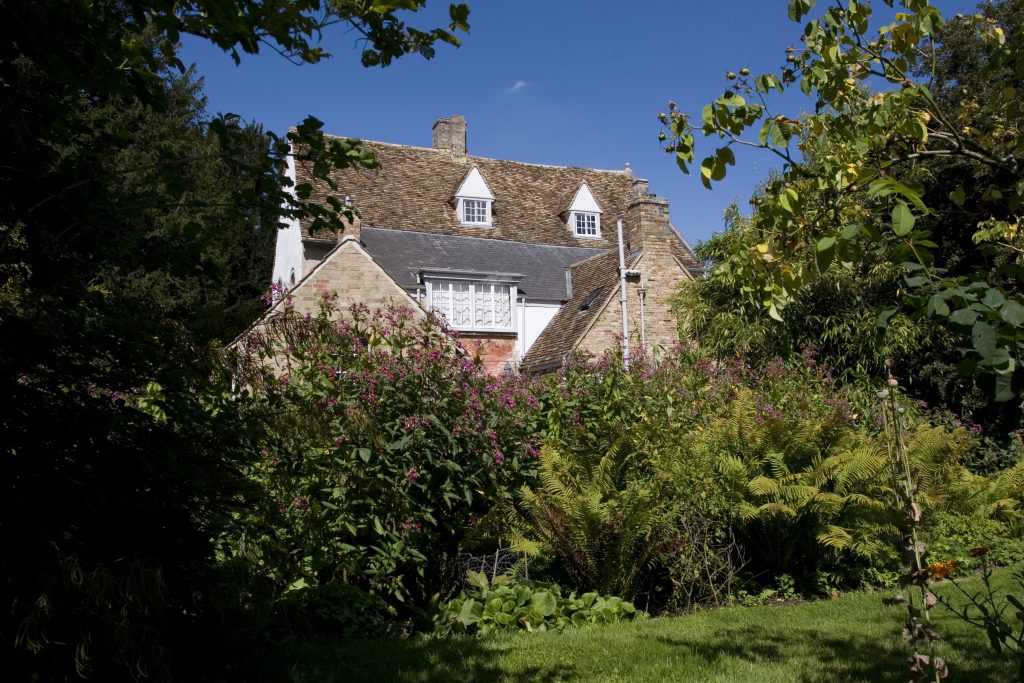
A side view of the house
In the Business
When Diana took over management of the manor her teaching experience must have helped her deal with the administration and present the tours, but there were many other jobs she had to learn to do very quickly too.
“At the age of 50 I had to learn to become a shop keeper, tour guide and head gardener. I had always been interested in gardening and that is really the thing I enjoy doing most, but unfortunately I spend more and more time trying to earn more and more money to pay more people to do what I actually want to do, all because of that stupid thing called admin!
“At the start of a typical day, I look in the diary to see what’s going to happen and sort out what I can do in between the tours. Obviously other people can do the tours as well but I do most of them. Then there are emails – endless, endless emails; stocking the shop so that the shelves are full for when the tours come round; trying to keep up with the accounts, which is the thing I am worst at doing. That’s hanging over me at the moment. Then there’s sorting out what’s going to happen in the garden.”
“When I do a tour I start by saying that I was born untidy and have been untidy ever since. It certainly isn’t sanitised. It’s not like going round a National Trust house. The Annexe at the back they wouldn’t want to see anyway, except for the Japanese visitors who do because a famous Japanese writer lived there. His name is Hayashi Nozomu, or Nozomu Hayashi as we would write it, Hayashi being his surname. Before him a transcriber of ancient manuscripts called Terrence Bishop lived there, who used to sit muttering to himself and absolutely spooked my children. He becomes Mr Pope in one of the books.
“They certainly don’t see my kitchen because I am the untidiest cook in Britain, but they get to see my bedroom. I can say to anyone who is standing by the door, ‘Would you like to go on up to my bedroom!’ They see our sitting room and when I have family staying the kids sleep in the attic and have to go up and make sure the beds are made and any mattresses that are on the floor, lifted up and hidden ready for it to be turned back into a museum.”
It is hard for most of us to imagine scores of strangers entering our homes and scrutinising what is inside, day after day, but Diana insists that it no longer troubles her. “You get absolutely used to it. People can’t imagine anybody living like that or wanting to show people around their home, but it gives one a good feeling. I’ll sometimes be unable to do the tours because my eldest daughter, Kate, has just had a baby, so I took on a new tour guide the other day, and after her first tour she came out saying that it was amazing how the visitors love it. People are never disappointed and I get letters and emails from all over the world saying that it was the cherry on the top of the cake of their visit to Britain.”
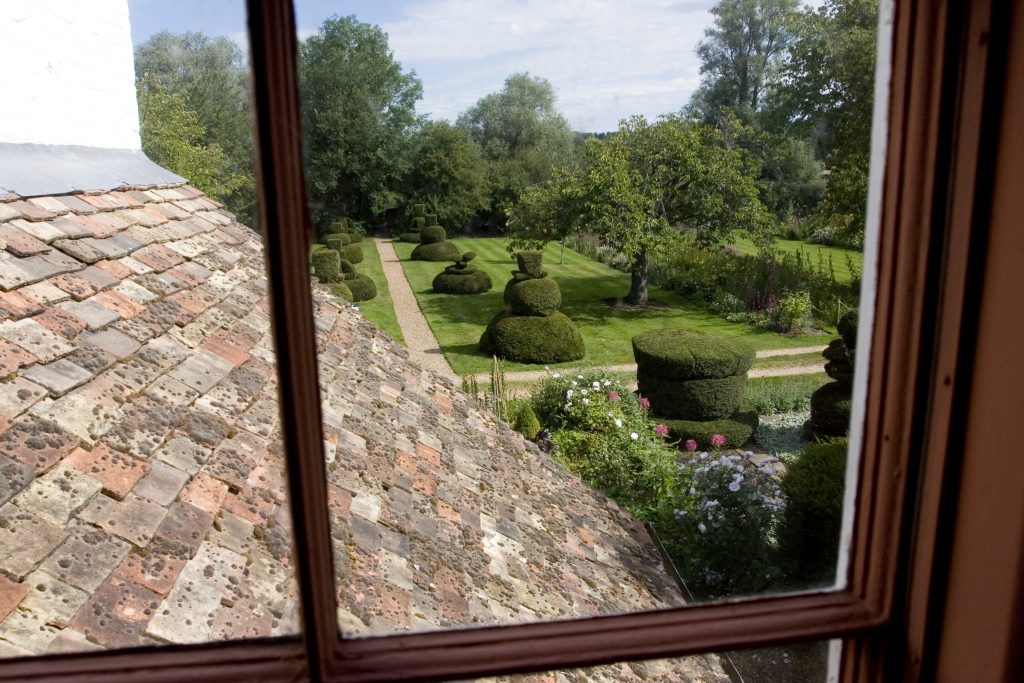
View from the landing out towards the river
The Manor Team
Maintaining a Grade I listing building and many acres of garden is not something one person can do for a sustained period of time. Two decades ago, when Diana took over the house, she had no choice but to do pretty much everything herself. These days she is helped by a dedicated team of people, all of whom seem to do a variety of jobs both inside and out. “Now I have several gardeners,” say Diana. “Janet Boyes does the topiary, helps with the tours and the shop, and does redecorating in the house. Graham Reeve does the mowing and is a general sort of handyman. He works the equivalent of two days a week. Kevin Swales, the gardener, works two-and-a-half days a week in that he does three days one week and two day the next. And there is Nel Hanson who does the equivalent of two days a week. Nel is one of the part-time gardeners but she also helps with the tours, manning the shop and helps care for the fabric of the house.
“When I started the debt was so huge I had to get rid of everybody who was working here. I say get rid of – Lucy’s main gardener, George Watson, was well and truly long beyond retirement age and quite wanting to give up. Then there was a young lad called Robin Wilson, who was a huge help to Lucy. He was destined for other things and is now big in the theatrical world designing masks for the Lion King. So they moved on and I did the gardening. Then I remember getting a royalty cheque for about £300 and thinking, ‘Right, I’m going to use that to get some help.’ I would think it was in about 1992 that I first started to get a bit of help in. He was a racing driver who used to come and do the mowing, but only with a push mower!
“It was absolutely hand to mouth. It is still hand to mouth, it’s just got bigger! The mouth has got bigger and the hand doesn’t quite work fast enough. It’s quite scary how much goes out each week.
“I remember talking to a woman who owned a huge stately home and she was saying that they were running to keep still. Their takings were two or three million, but it just got bigger and bigger so they had to pay more and more people and there’s a huge danger in that. I don’t want to turn it into a juggernaut because I also live here.
“When my grandchildren Emily and Jake were little they used to play visitors. One day they were walking down between the flower beds pretending to look at everything and Harriet, my youngest daughter, asked them, ‘What are you doing?’ and they said ‘We are playing visitors.’
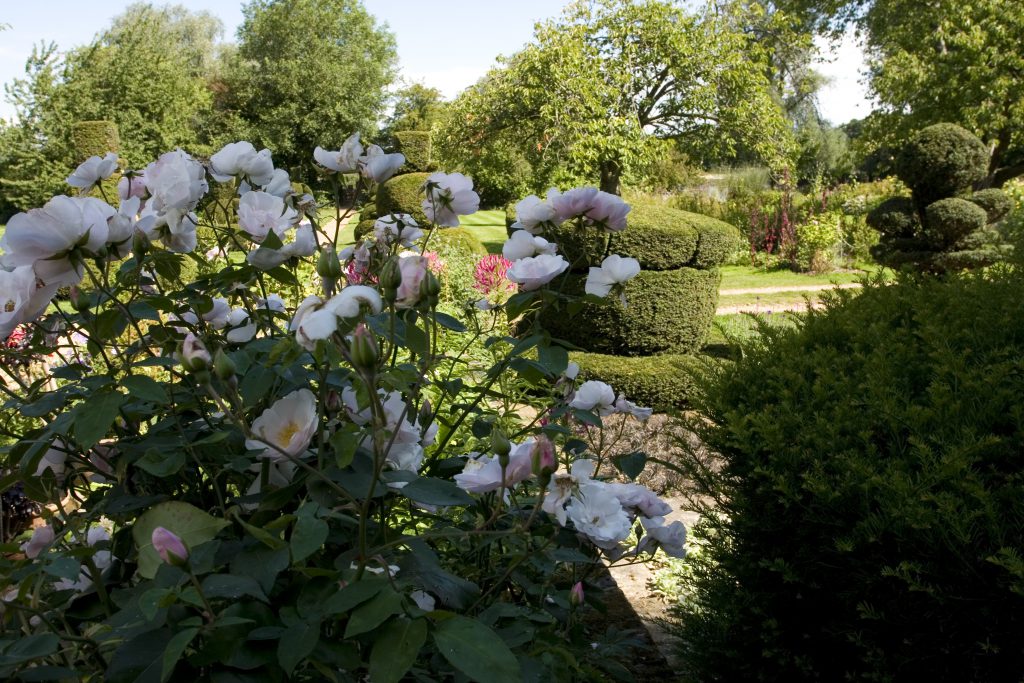
View from near the door
Cut and Shape
Besides writing her children’s books, Lucy Boston was a very keen gardener and maker of patchwork quilts and continued with both activities right up until she died. Many of her patchworks are formed from intricately arranged geometric shapes, which look as thought they were inspired by flowers and leaf patterns. “They are all, except for one,” says Diana, who has written a book called The Patchworks of Lucy Boston, “completely traditional mixtures of shapes and she was just playing around with these mixtures and experimenting. She was an artist and brings her artistic side to her patchworks, books and garden. What interested her was pattern and colour when making patchworks,.”
In her garden, Lucy enjoyed working with nature, rather than battling to overcome it. She writes in the notes at the end of A Stranger at Green Knowe: ‘My approach to gardening is to find out how the garden would like to be – what wants to grow where. My chief pleasure in it is the interplay of sun and shadow among trees and on the face of the house.’
Of interest to most children, however, are the many topiary bushes, which stand like characters alongside the garden path, and amongst some of the flower beds. One rotund bush, with battlement shapes on top and a hole in the bottom, was the inspiration for Lucy’s book The Castle of Yew. At the time our photographs were taken, one of the knights was being clipped by Janet Boyes to match another which had already been shaped. “The longer you leave it, the harder it becomes to find the shape within,” commented Janet.
When it comes to experimenting with new planting and colours ideas, Diana relies on the expert advice of her dedicated gardeners. It seems that a certain amount of democracy is at play, although Diana claims that it is more out of laziness than an attempt at democracy. “I think the garden tends to belong to everybody who works on it,” she continues. “They all have a vested interest in liking what they are working on. I think people do enjoy the garden and I keep being told what a lovely garden I have got. Now that I’ve got efficient people working in it, I can go around enjoying what is there rather than thinking ‘Oh my goodness! Look at all that bindweed coming up in the middle there.’
“Inevitably I introduce new plants into the garden; I am not sticking religiously to Lucy’s original rule of never planting roses that were bred after 1900, although even she changed that in the end. Because the garden is open to the public I need roses that go on flowering a little bit later. I keep the structure of the garden the same but replace trees where necessary.
“I spend more on plants than I do on clothes, inevitably, as do most gardeners, I think. I do go to the Malvern show and come back with plants. I won’t have pre-planned where they are going to go, so everybody then has to put on their thinking caps to find room for something new.
“I wouldn’t be allowed to do anything as radical as dig up all the roses because of the conditional capital tax exemption. It is not actually counted as a heritage garden for some reason. I don’t know whether they will go on minding about that or how much they notice really, but I don’t want to change it too much. I’m not sure if there is room for improvement. I don’t have time to worry about that sort of thing.”
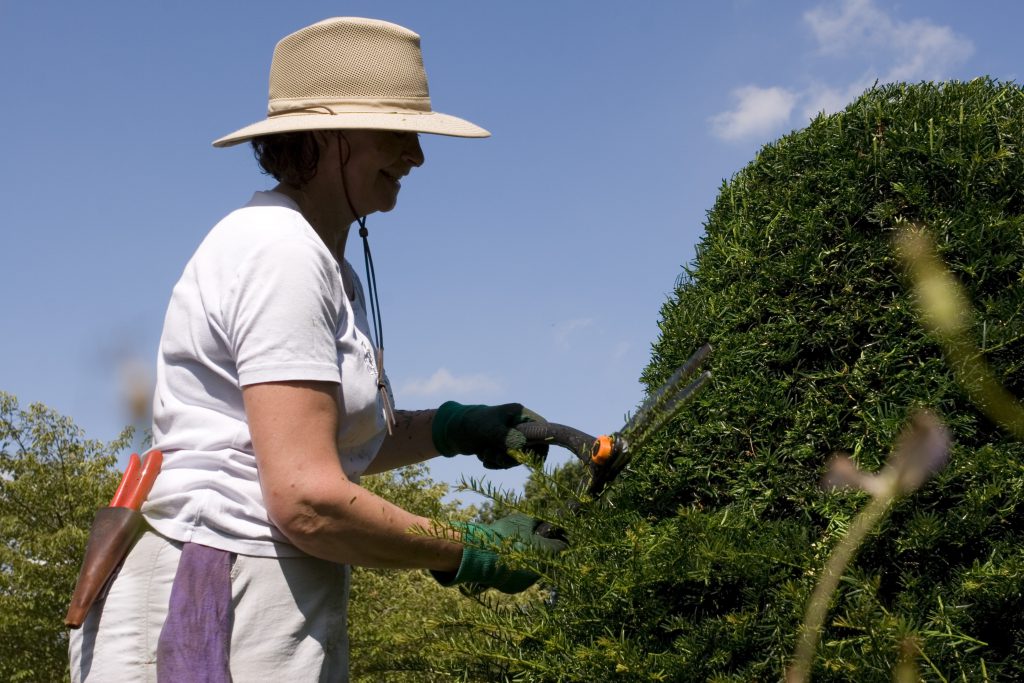
Janet Boyes at work
Why They Like the Manor
Perhaps the key to the success of the Green Knowe books is that all six in the series centred on a single place, thereby giving the reader a comforting sense familiarity. For people who have moved around a lot, or those who live in a busy city or dense housing development, the remote village world of Green Knowe offers something fresh and appealing. At the age of 11, Lucy herself moved from a town environment she did not care for, to a country setting she adored. It seems that her books were often an attempt to recreate the world and feeling she experienced at that time in her life.
“Lucy consciously wrote to give a sense of place and sense of continuity,” agrees Diana, “as if it were the same family being there from the day the house was built in 1130 right through to the day she died. I don’t know how consciously people think about that but I think they do like continuity and that sense of place. That is possibly one of the things people love about the books; because less and less people are having that experience. I suppose there are not many books that are so much about a place that you can come and recognise it all.
“That is also because Peter did the illustrations and drew what was here. The little mouse that the child goes to bed with, for example, reduces the people who have read the books to tears. And the tears are international, it doesn’t matter whether they are Japanese or British, they still get very emotional when they find they can actually hold the mouse and stroke it!
“Of course, some people don’t like fantasy. My chum at teaching college never read the books because she didn’t like fantasy, but I used to read a bit of The Sea Egg to seven year olds that I was teaching, and got them to go on with their own story. I used to get wonderful stories, use of language and poetry from them afterwards.”
In 2009, Lucy’s book The Chimneys of Green Knowe was made into a film called From Time To Time. Julian Fellowes adapted the book for film and also directed, casting Maggie Smith as Mrs Oldknowe and Timothy Spall as Boggis. He was particularly attracted to The Chimneys of Green Knowe because of its supernatural storyline – perhaps mindful of the success of fantasy films like the Harry Potter series and The Chronicles of Narnia – but was disappointed that other books in the series did not involve ghosts.
“He was wondering why Lucy didn’t go on with her ghost stories,” explains Diana. “Lucy played around with the writing and wrote ghost stories well before the Green Knowe series and her move to the manor, but only two were published. She used to make them up to tell Peter and his cousins. In fact there is a new publication of her ghost stories which is just about to come out. She was a great M. R. James fan and that is one of the reasons I host M. R. James ghost stories here in the winter.
“A Stranger isn’t a ghost story, nor is River or Enemy. Julian would never have been interested in doing any of the ones that weren’t. He would have only have been interested in doing The Children, The Chimneys, The Stones, and possibly Enemy if that could have been made a bit more ghostly. He couldn’t understand why she had changed within the Green Knowe label – why the books are so completely different. She wasn’t sticking to one pattern.”
Lucy did live long enough to see her story The Children of Green Knowe made into a four-part BBC period drama, originally broadcast in November and December 1986. The manor itself was used in the location filming. Further back still, the BBC’s Jackanory featured The Children of Green Knowe in a five part series broadcast in December 1966, and The Castle of Yew in a two-part adaptation shown in December 1969.
By the time the book rights fell to Diana, Lucy’s work was not especially in vogue. Many titles were out of print and, as the publishers focused their attentions on new books, nothing was done to address the matter.
“The books were not doing hugely well then, they were just chuntering along,” say Diana. “They were on Faber’s and Puffin’s backlists so they were not exactly going to push them and gradually they began to go out of print. The Children of Green Knowe has never been out of print since it was published in 1954, but the others did so I got the rights back and published them myself.
“When they are out of print you just have to give notice that you are going to take them back unless the publisher does a reprint. And so I gave notice and we went through the six months, or whatever it was, and got them back. Faber still own the rights to two Green Knowe books, and I have the rights to the other four, so I published the other four to match Faber’s ones with their agreement. They were very cooperative about it.
We retained the same artwork – everything. Then I also republished her two autobiographical books and published my own book about her patchworks. Originally the autobiography was published by a little publishing house in Cambridge called Cult Books, as was the patchwork book, so I paid part of the costs of the publications.”
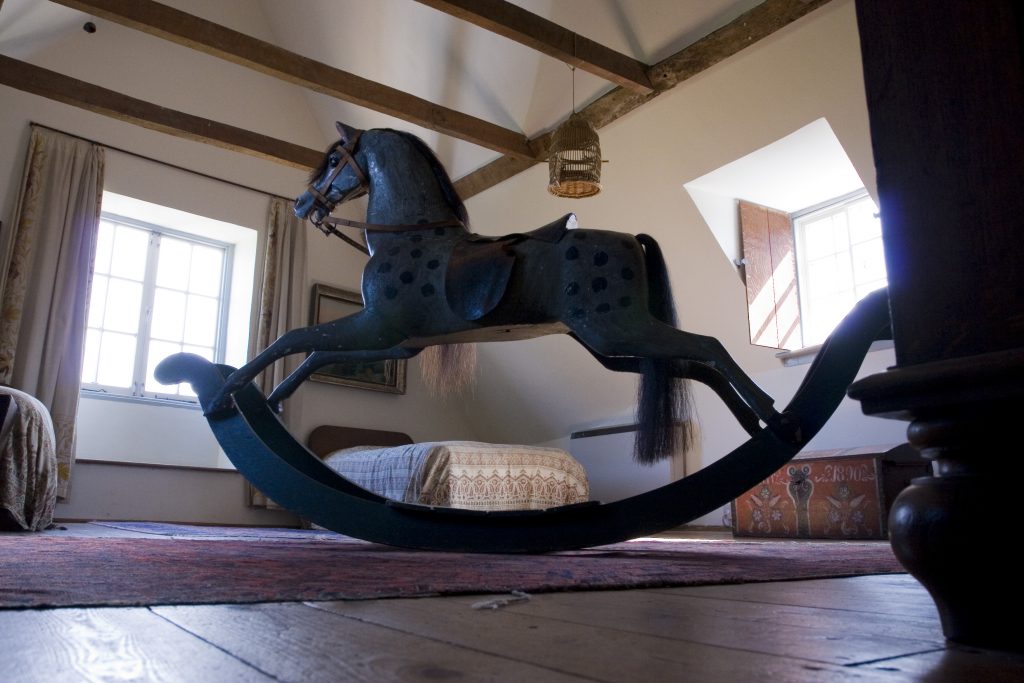
The bedroom in the attic
The Future of Green Knowe
The Manor has existed, in one form or another, for close to 900 years, possibly even longer. The relatively recent success of Lucy’s books has brought it worldwide fame and notoriety, but even that might turn out to be nothing more than a brief chapter in its history. For the moment, however, Lucy’s vision lives on, under the careful governance of Diana. She explains what she envisions for the future, when it is time for her to go.
“I have told my children that they are completely not to feel that I am pulling the strings from the other side of the grave. People have to do what they want and not feel that they owe it to me. I’ve had my fun keeping it. They love it and wouldn’t easily part with it as we didn’t easily part with it, but who knows.”
Of course, Diana’s decision about what to do with the estate would be made easier if some of her children displayed a particular interest in heritage, gardens or architecture, while other did not, but as she puts it, “they all are interested in some of all of that! Maybe they’ll run it together. I don’t know, we’ll have to see.
“I have four children but only Kate and Harriet are Bostons. Andrew and Charles are Robertsons so, in a way, it’s not their inheritance. It’s very difficult. Lucy only had Peter so didn’t have to split things equally between any others. That’s the difficulty with inheritance.”
“Of course, the grandchildren love it and come here often. I mean it’s second home to them. I was really sorry Lucy hadn’t been here when my youngest daughter Harriet read The Children of Green Knowe to her first set of twins Emily and Jake. I invited Emily and Jake to a Green Knowe tea and suddenly they saw the Green Knowe house through completely different eyes. It was very exciting. Such a shame Lucy wasn’t here to see their pleasure in her writing and everything here.” TF
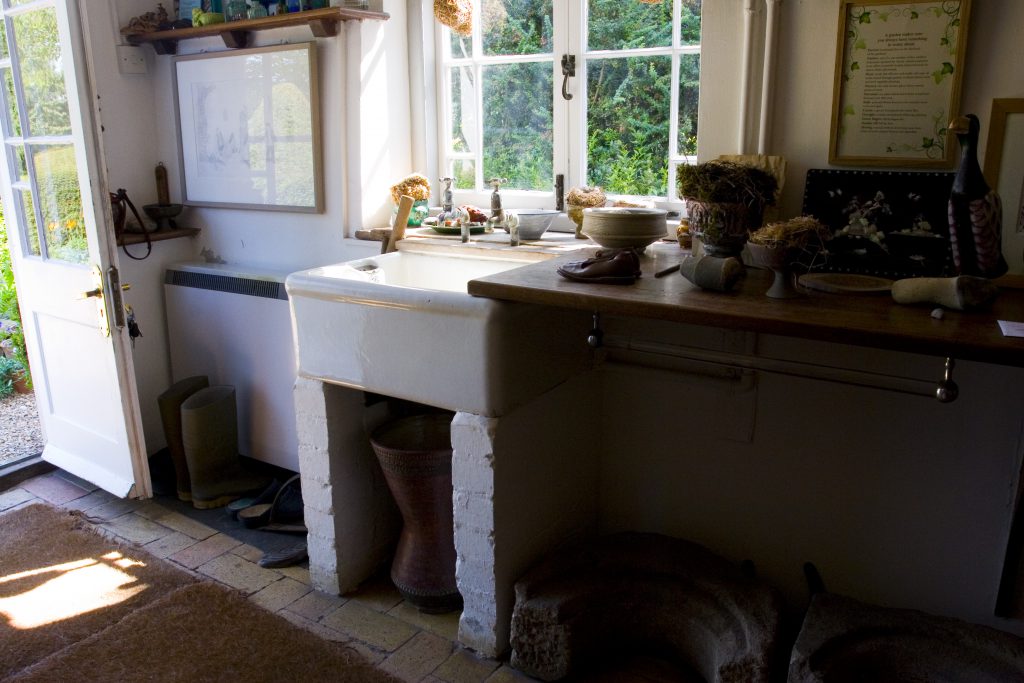
Boots off!
Part 1 of this interview with Diana can be found here: Part 1
Interested in children’s books? See our interview with Graham Oakley here: Graham Oakley
The Manor opening times and other information can be found on Diana’s site here: www.greenknowe.co.uk

